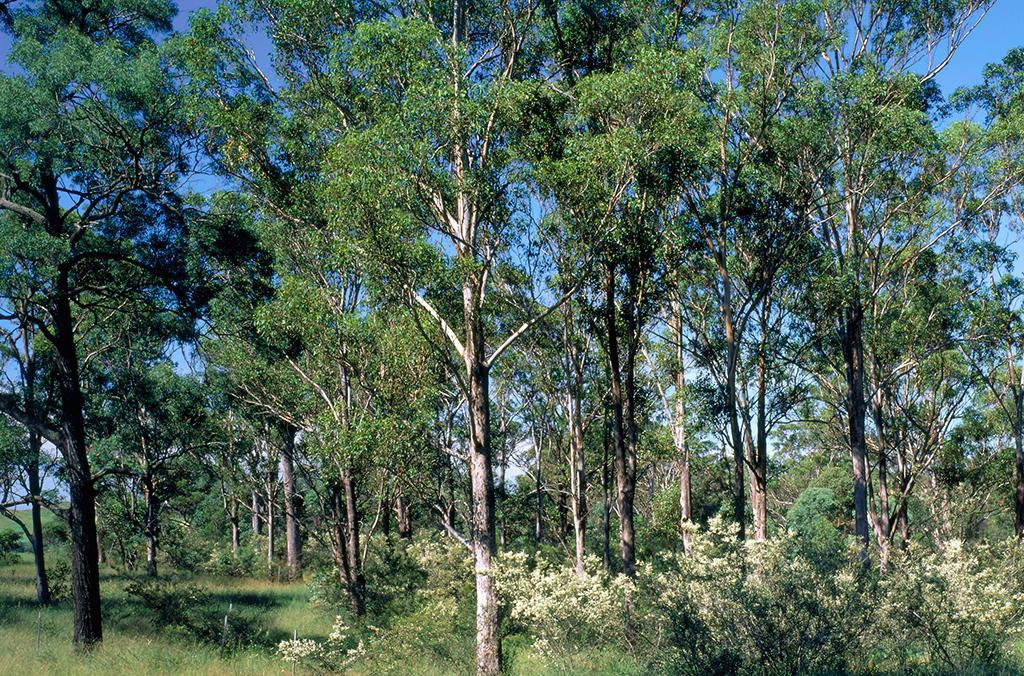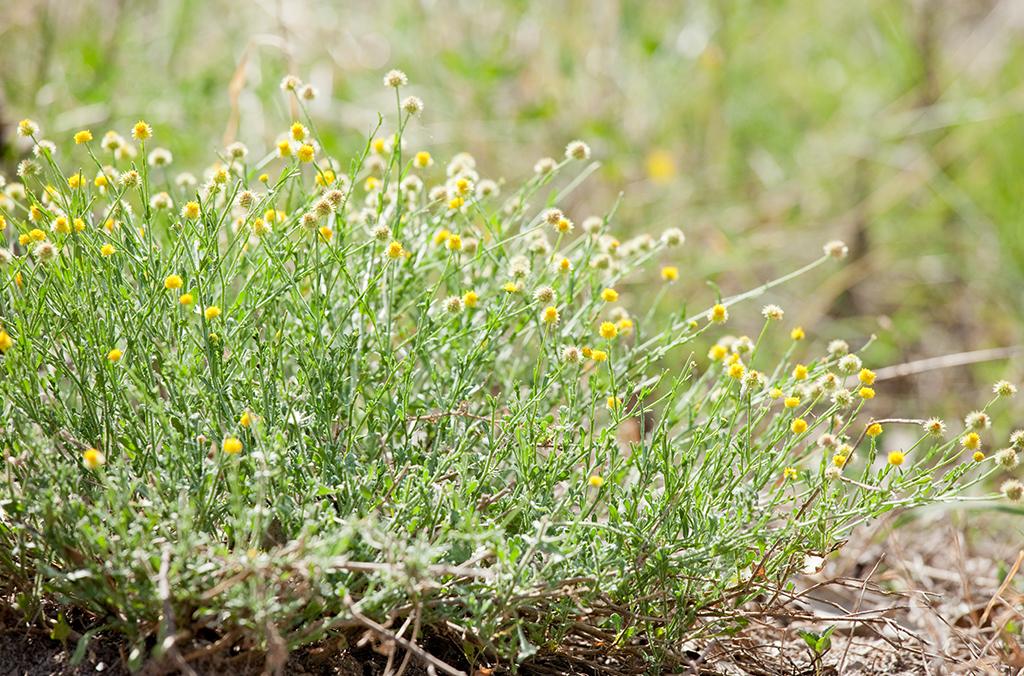Plant species in the woodland
The woodland contains many different organisms but plants are the biggest and most obvious. A few species are trees but most are groundlayer plants, which make up about 90% of the flora.
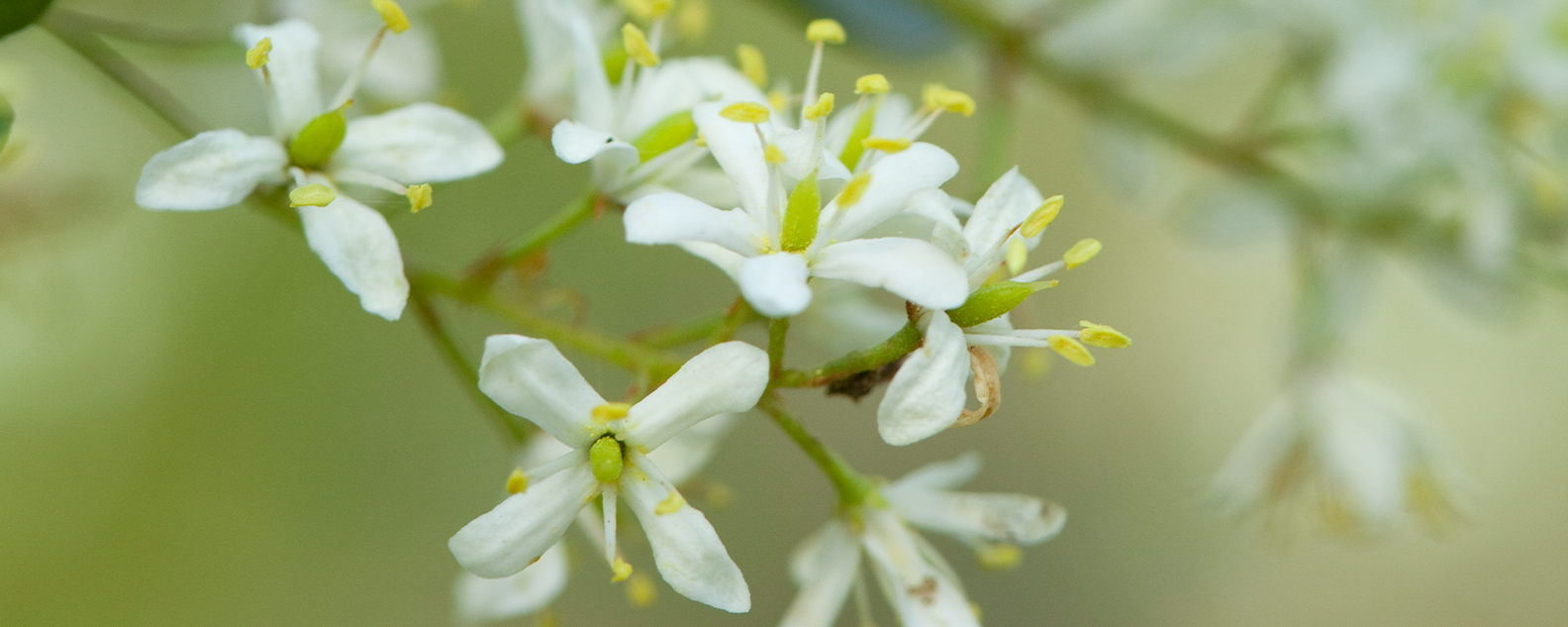
Cumberland Plain Woodland typically has a canopy of gum trees (species of Eucalyptus, 10-20 m high) with a grassy and herbaceous understorey. There may be scattered clumps or thickets of shrubs.
The multitude of groundlayer plants are not big and showy like the Banksias and Grevilleas of the sandstone areas, but small delicate creatures that need a careful eye to distinguish between them. Modern photography allows us to really appreciate their delicate beauty.
Our remnant woodlands at the Australian Botanic Garden, Mount Annan contain about 130 native plant species, as well as about 80 exotic weed species that have naturalised (i.e. spread into various habitats). The predominant plant family is the Grass family Poaceae with 40 species (25 native and 15 exotic), followed by the Daisies - Asteraceae with 33 species (20 native and 13 exotic), the Peas - Fabaceae with 16 species (11 native and 5 exotic) and Chenopods - Chenopodiaceae with 7 species (all native). Most of the other families are represented by only a few species. There are four fern species.
The woodland flora has most affinities with dry country areas, and many of the species also grow in drier inland NSW. Mount Annan, with an average annual rainfall of 825 mm, is part of the driest part of Sydney, and most of the native woodland plants are adapted to periodic droughts and dry conditions.
Many of the exotic species were introduced and spread around by domestic stock in the 19th and 20th centuries when the land was used for grazing and agriculture. A few of the exotic species are horticultural or ornamental plants that have run wild, notably African Olive *Olea europaea subsp. cuspidata, Cotton Bush *Gomphocarpus fruticosus, Paddys Lucerne *Sida rhombifolia and Heliotrope *Heliotropium amplexicaule.

Vascular plants
Discover the diversity of plant species, both native and exotic, found in the Cumberland Plain Woodland remnants at the Australian Botanic Garden.
In the image galleries and plant list below, species are divided by lifeform into trees, shrubs, vines and climbers, ferns, groundcovers and specialised lifeforms.
Vascular plant species by lifeform and family, with habitat notes
| Life form | Genus and species with habitat notes | |
| Trees |
|
| Life form | Genus and species with habitat notes |
| Shrubs | Acacia decurrens Acacia falcata Acacia implexa Acacia parramattensis Bursaria spinosa Cassinia longifolia Cassinia macrocephala Cassinia quinquefaria Clerodendrum tomentosum Daviesia ulicifolia Dodonaea viscosa subsp. cuneata Exocarpos cupressiformis Indigofera australis *Lantana camara Leucopogon juniperinus *Lycium ferocissimum Myoporum montanum *Olea europaea subsp. cuspidata Ozothamnus diosmifolius *Rosa rubiginosa Rubus parvifolius *Rubus ulmifolius |
| Life form | Genus and species with habitat notes |
| Vines and climbers | *Araujia sericifera Cayratia clematidea Clematis glycinoides Convolvulus angustissimus Marsdenia rostrata Marsdenia viridiflora Pandorea pandorana Parsonsia straminea Passiflora herbertiana |
| Life form | Genus and species with habitat notes |
| Ferns | Adiantum aethiopicum Riverflat Forest Asplenium flabellifolium Azolla sp. Aquatic habitat Cheilanthes distans Cheilanthes sieberi Pellaea falcata |
| Life form | Genus and species with habitat notes |
| Daisies - Asteraceae | *Arctotheca calendula *Bidens pilosa Brachyscome angustifolia Calotis lappulacea *Carthamnus lanatus Grassland habitat Cassinia quinquefaria Cassinia uncata Centipeda minima Dam habitat Chrysocephalum apiculatum *Cirsium vulgare *Conyza sumatrensis Cotula australis Cymbonotus lawsonianus Euchiton gymnocephalus Euchiton sphericus *Facelis retusa *Gamochaeta americana Glossocardia bidens *Hypochaeris microcephala var. albiflora *Hypochaeris radicata Lagenophora gracilis *Leontodon taraxacoides Olearia viscidula Ozothamnus diosmifolius Rhodanthe anthemoides Senecio hispidulus *Senecio madagascariensis Senecio quadridentatus Solenogyne bellioides Solenogyne dominii *Soliva sessilis *Sonchus asper *Sonchus oleraceus *Taraxacum officinale *Tragopogon porrifolius Grassland Triptilodiscus pygmaeus Vernonia cinerea Vittadinia sulcata |
| Life form | Genus and species with habitat notes |
| Chenopods - Chenopodiaceae | Atriplex semibaccata Chenopodium carinatum Einadia hastata Einadia nutans subsp. linifolia Einadia nutans subsp. nutans Einadia polygonoides Einadia trigonos Salsola kali Grassland habitat |
| Life form | Genus and species with habitat notes |
| Peas - Fabaceae | Acacia decurrens Acacia falcata Acacia implexa Acacia parramattensis Bossiaea prostrata Daviesia ulicifolia Desmodium brachypodum Desmodium varians Glycine tabacina Hardenbergia violacea Indigofera australis Lotus australis *Medicago lupulina *Trifolium arvense Grasssland habitat *Trifolium repens *Trifolium glomeratum Zornia dyctiocarpa |
| Life form | Genus and species with habitat notes |
| Other dicotyledon herbs | Ajuga australis Alternanthera sp. A *Alternanthera pungens *Anagallis arvensis Asperula conferta Brunoniella australis *Centaurium tenuiflorum *Cerastium glomeratum Chamaesyce drummondii Crassula sieberiana *Cyclospermum leptophyllum Cynoglossum suaveolens *Datura stramonium Daucus glochidiatus Dichondra repens *Echium plantagineum Eremophila debilis *Erodium cicurtarium Roadside habitat Erodium crinitum *Foeniculum vulgare Grassland habitat Galium migrans Geranium homeanum *Gomphocarpus fruticosus *Gomphrena celosiodes Roadside Goodenia hederacea Gratiola pedunculata Dam habitat *Heliotropium amplexicaule *Hibiscus trionum Grassland habitat *Hydrocotyle bonariensis Dam habitat Hypericum gramineum *Hypericum perforatum *Lamium amplexicaule Grassland *Lepidium africanum *Lepidium bonariense Linum marginale *Linum trigynum Ludwigia peploides Dam habitat Lythrum hyssopifolia Dam habitat Lythrum salicaria Dam habitat Mentha satureioides *Modiola caroliniana Nymphoides montana Aquatic habitat Opercularia diphylla *Opuntia stricta Ottelia ovalifolia Aquatic habitat Oxalis perennans *Paronychia brasiliana *Pavonia hastata Grassland habitat Persicaria decipiens Dam habitat *Petrorhagia nanteuilii Phyllanthus virgatus *Phytolacca octandra Pimelea glauca Pimelea spicata Plantago gaudichaudii *Plantago lanceolata *Plantago myosuros Plectranthus parviflorus *Polycarpon tetraphyllum Polygala japonica *Polygala virgata Grassland habitat Poranthera microphylla Portulaca oleracea Pratia purpurescens Ranunculus lappaceus Ranunculus sessiliflorus *Richardia stellaris Rumex brownii *Rumex crispus Grassland habitat Scaevola albida Scutellaria humilis *Sherardia arvensis Sida corrugata *Sida rhombifolia *Silene gallica Solanum cinereum *Solanum linnaeanum *Solanum nigrum Solanum prinophyllum *Solanum pseudocapsicum *Stachys arvensis Stackhousia viminea *Stellaria media *Verbascum virgatum *Verbena bonariensis *Verbena officinalis *Verbena rigida Veronica plebeia Wahlenbergia communis Wahlenbergia gracilis Wahlenbergia stricta |
| Life form | Genus and species with habitat notes |
| Grasses - Poaceae | Aristida ramosa Aristida vagans Austrodanthonia fulva Austrodanthonia racemosa Austrostipa setacea *Avena barbata Grassland habitat Bothriochloa macra *Briza maxima *Briza minor *Briza subaristata *Bromus catharticus *Bromus molliformis *Chloris gayana Chloris truncata Chloris ventricosa Cymbopogon refractus *Cynodon dactylon Dichanthium sericeum Dichelachne micrantha Digitaria diffusa Digitaria divaricatissima Grassland Echinopogon ovatus Elymus scaber *Eragrostis curvula Roadside habitat Eragrostis leptostachya Eriochloa pseudoacrotricha *Festuca arundinacea Lachnagrostis filifomis *Lolium perenne Microlaena stipoides *Nassella neesiana Oplismenus aemulus Panicum effusum Paspalidium distans *Paspalum dilatatum *Phalaris aquatica Poa labillardierei *Setaria parviflora Sorghum leiocladum *Sporobolus africanus Sporobolus creber Themeda triandra *Vulpia bromoides |
| Life form | Genus and species with habitat notes |
| Other monocotyledons - graminoids | Alisma plantago-aquatica Aquatic habitat Arthropodium minus Arthropodium sp. B *Asparagus asparagoides Caesia parviflora Carex breviculmis Carex inversa Cyperus gracilis Cyperus gunnii Dam habitat Damasonium minus Dam habitat Dianella longifolia Dianella revoluta Dipodium punctatum Fimbristylis dichotoma Geitonoplesium cymosum Dry Rainforest habitat Hypoxis hygrometrica Juncus prismatocarpus Juncus subsecundus Juncus usitatus Lomandra filiformis subsp. filiformis Lomandra multiflora Pterostylis curta *Romulea rosea Scleria mackaviensis *Sisyrinchium sp. Tricoryne elatior Typha domingensis Dam habitat Typha orientalis Dam habitat |
| Life form | Genus and species with habitat notes |
| Specialised lifeforms | Amyema miquelii |
Asterisk * indicates exotic species naturalised at the Australian Botanic Garden.
Mosses
Mosses and the related liverworts belong to the bryophyte group of plants.
Mosses and liverworts are simple plants with no developed vascular system, normally found in wet places. There are a number of species in the Cumberland Plain woodland at the Australian Botanic Garden. They grow on soil surfaces and are generally conspicuous in cool wet weather.
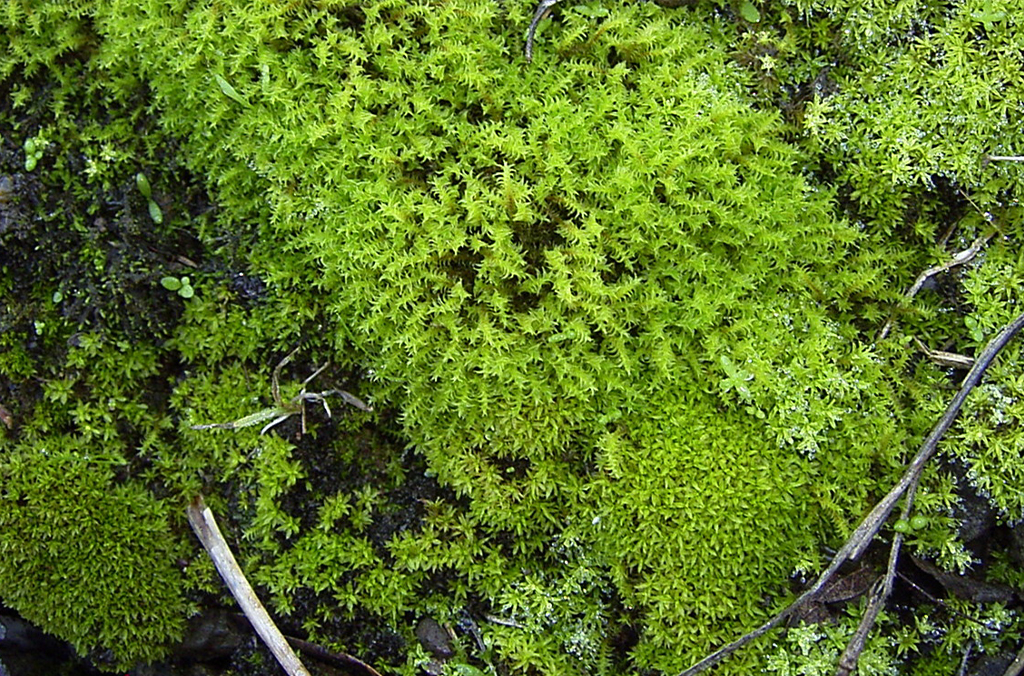

Fungi
Fungi are usually found after good rain and particularly during the cooler autumn months in the Conservation Woodland at the Australian Botanic Garden Mount Annan.
So far we have noted several species of fungi in the woodland at the Australian Botanic Garden. These include mushrooms, toadstools, puff balls, bracket fungi and slime moulds. Some are native and others are introduced. The mushroom is the fruiting body of the organism, beneath these are the thin ‘root like’ net of hyphae that is the feeding system which may extend for many metres and may sometimes form ‘fairy rings’.
Fungi cannot make their own food like higher plants. They are saprophytic and feed on rotting material. Some are found on rotting wood and logs while others grow in the soil. Some may form symbiotic relationships with plants helping them take up nutrients. We know very little about plant fungi relationships in our woodland, however one species here, Calvatia lilacina has been reported in China to be an ectomycorrhizal fungi ie associated with plant roots.
Lichens
Colours range from grey to orange, and they occur in a variety of different places. Some grow on dead branches, some on rotting logs, some on the soil and on rocks. Lichens are important in providing soil surface protection against erosion in dry habitats.
Lichens are interesting organisms made up of symbiotic relationships between a fungus (mycobiont) and a green alga or cyanobacteria (photobiont), with the fungi providing the structure and the algae the green ‘chlorophyll’ part.
This symbiotic association has been so successful that there are now about 20,000 species of lichens, represented in most habitats in the world.
Lichens may be a particularly conspicuous part of the ground cover in the Cumberland Plain woodland at the Australian Botanic Garden and we have recorded a number of species below. Identification may be difficult, requiring fruiting bodies that are not always present and we have photos of a few as yet unidentified specimens.
Lichens form fascinating shapes and structures and a number of broard groups are recognised:
- foliose lichens have lobed growth forms
- crustose lichens look like thin crusts and are firmly attached over their entire underside
- squamulose lichens look like thin flakes or crumbs scattered over the surface
- fruticose lichens are erect or pendulous, markedly three dimensional and attached at the base
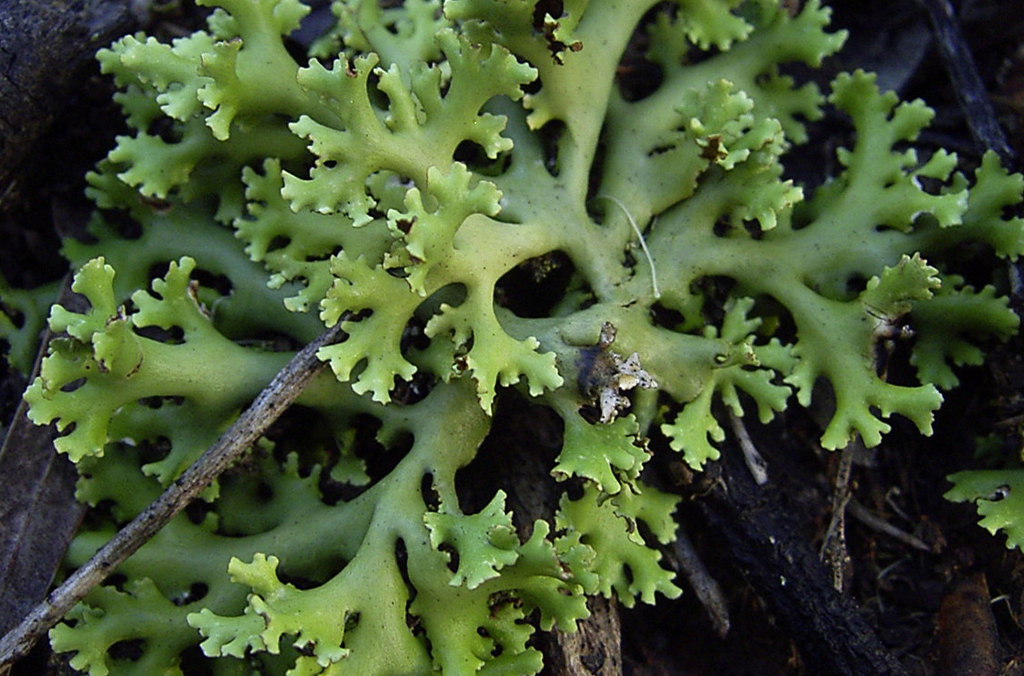
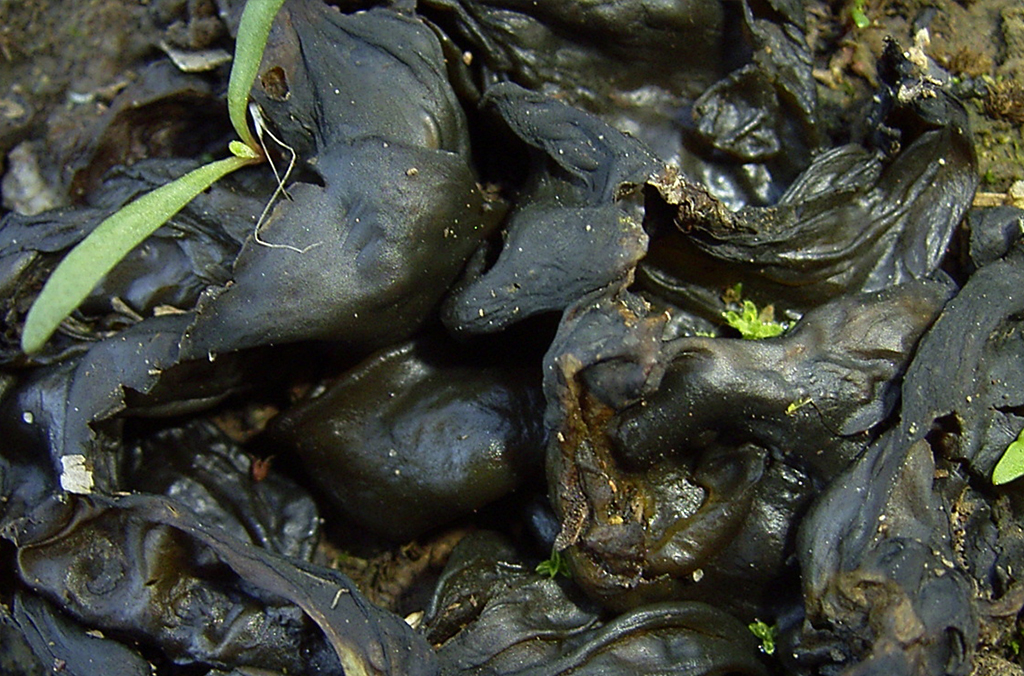
Other microscopic organisms
Microscopic organisms in the Cumberland Plain Woodland at the Australian Botanic Garden Mount Annan include algae, bacteria and protozoans.
Most of these are soil inhabiting and involved in breakdown of dead plant and animal material and are important in recycling of organic matter. Some may cause disease. We know very little about the organisms involved.
Examples
Nostoc commune is a an alga that forms a jelly like growth on the soil surface during wet conditions (see title image).
Rhizobium species are bacteria that fix nitrogen in the roots of species of peas (Fabaceae).
